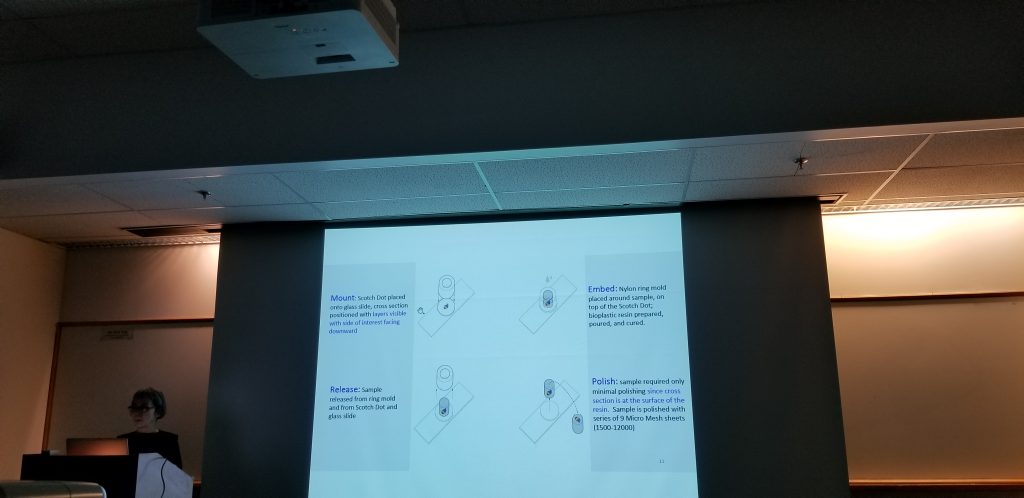Jia-sun Tsang (MCI Senior Paintings Conservator), Elle Friedberg (MCI Paintings Conservation and Analytical Studies Intern), and Thomas Lam (MCI Physical Scientist), Museum Conservation Institute, Suitland

At WCG’s annual 3-Ring Circus, Jia-sun Tsang of the Smithsonian’s Museum Conservation Institute presented a speedy, simple in-house method of creating paint cross sections for instrumental analysis.. A new method was desired that would enable the study of modern and contemporary paintings, mixed media paints (including commercial, industrial, and homemade grades), and aged, deteriorated, or water sensitive paints – all while being easy and accessible to a conservator in a busy practice.
To create the cross section, a glass slide is used as the base. A Scotch® Restickable Dot (2.2 cm) is placed on top of the slide. The paint sample is placed on the adhesive dot with the side of interest facing down onto the adhesive, over which a nylon ring mold (2 cm exterior, 1.2 cm interior, 1 cm high) is placed. Bio-Plastic® resin (a two-part synthetic polyester resin) is poured in the mold and cured by heating it at 48°C for three hours in oven or overnight at room temperature. The cross section is released by tapping the mold. Because the sample is at the surface of the resin, only minimal polishing is needed using a series of Micro-Mesh™ sheets (grades 1,500 to 12,000).
This new method resolves several disadvantages of standard cross section methods. The epoxy normally used to embed cross sections can be problematic when paint pigments leach into the resin, as well as being difficult to polish and yellowing with age. Bio-Plastic ® resin is compatible with dry polishing methods as needed, causing minimal disruption to paint morphology and no mess. No water or solvents are needed for polishing, so more sensitive materials can be analyzed. Other advantages of the Bio-Plastic ® resin include that it cures at room temperature overnight or 48 °C for 3 hours in an oven, it cuts well, and there is minimal shrinkage. Additionally, the materials used to make these cross sections are inexpensive and the nylon ring molds are reusable.
Several case studies were presented that highlight the broad applicability of this new cross section method. The first was of Big Egg by Ed Clark (1968) in the National Museum of African American History and Culture’s collection. The artist created the piece by pushing paint around on canvas on the floor with a broom. The many layered sample was difficult to analyze with normal cross section methods because the PVAc binders are water sensitive. Using the new cross section method, 13 layers were found in the sample including PVA and house paint. The paint sample was then analyzed with SEM and FTIR . This case study was published in the Journal of the American Institute for Conservation.
The second case study discussed the SEM-EDS analysis of zinc soaps found in gel pool formed on accelerated and naturally aged oil painting test panels. It was shown that the zinc concentration was lowest in the center of these gel pools and highest at the outer edges, which helped identify zinc migration patterns. This study was published in Studies in Conservation.
Other case studies included:
- Studying acrylic paint morphologies, which can be interferred by solvents released in resin in other cross section methods
- Analyzing polychrome sculpture at the National Museum of African Art with Object Conservator Ashley Jehle
- Analyzing egg tempera (commercial grade) using SEM and HIROX imaging
- Studying gelatin silver photographs with MCI Photograph and Paper Conservator Shannon Brodgon-Grantham using SEM and HIROX imaging
- Analyzing porcelain with Cooper Hewitt Smithsonian Design Museum Objects Conservator Sarah Barack using HIROX and SEM-EDS. With porcelain, normally a 3 mm sample is needed, but analysis was successful using a 1.5 mm sample and the new cross section method allowed for better fine detail to be observed
In summary, this new cross section method was designed for complex and multi-layered modern and contemporary paintings, but the easy preparation with minimal disruption to the sample makes it a feasible method for other materials. Tsang brought samples of the cross section preparation supplies to the presentation. The authors are interested in applying the cross section and analysis methods to other materials, so they invited attendees to reach out and try it with them.
Related Publications:
Christine Romano, Thomas Lam, G. Asher Newsome, Joshua A. Taillon, Nicole Little & Jia-sun Tsang (2020) Characterization of Zinc Carboxylates in an Oil Paint Test Panel, Studies in Conservation, 65:1, 14-27, DOI: 10.1080/00393630.2019.1666467
Jia-sun Tsang, Elle Friedberg & Thomas Lam (2019) An easy-to-use method for preparing paint cross sections, Journal of the American Institute for Conservation, 58:3, 123-131, DOI: 10.1080/01971360.2018.1564198
Summarized by: Beth Knight, Textile Conservator in private practice